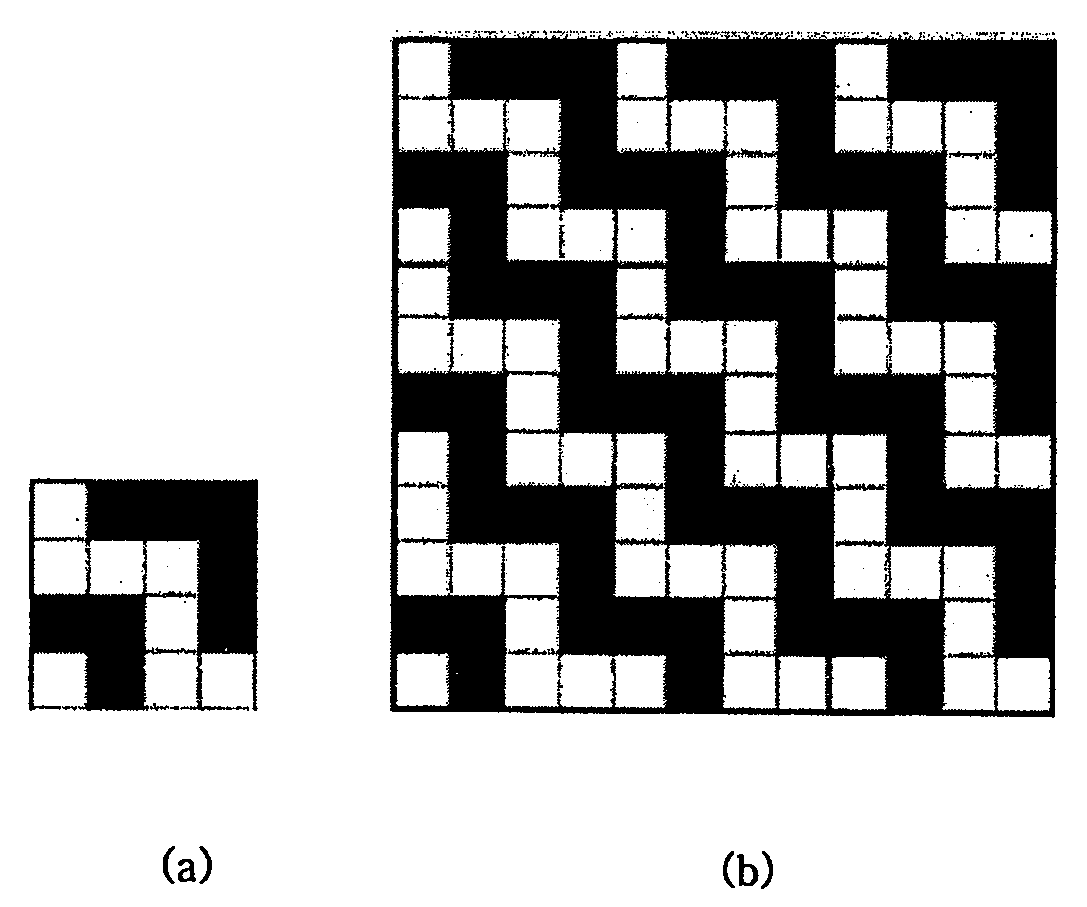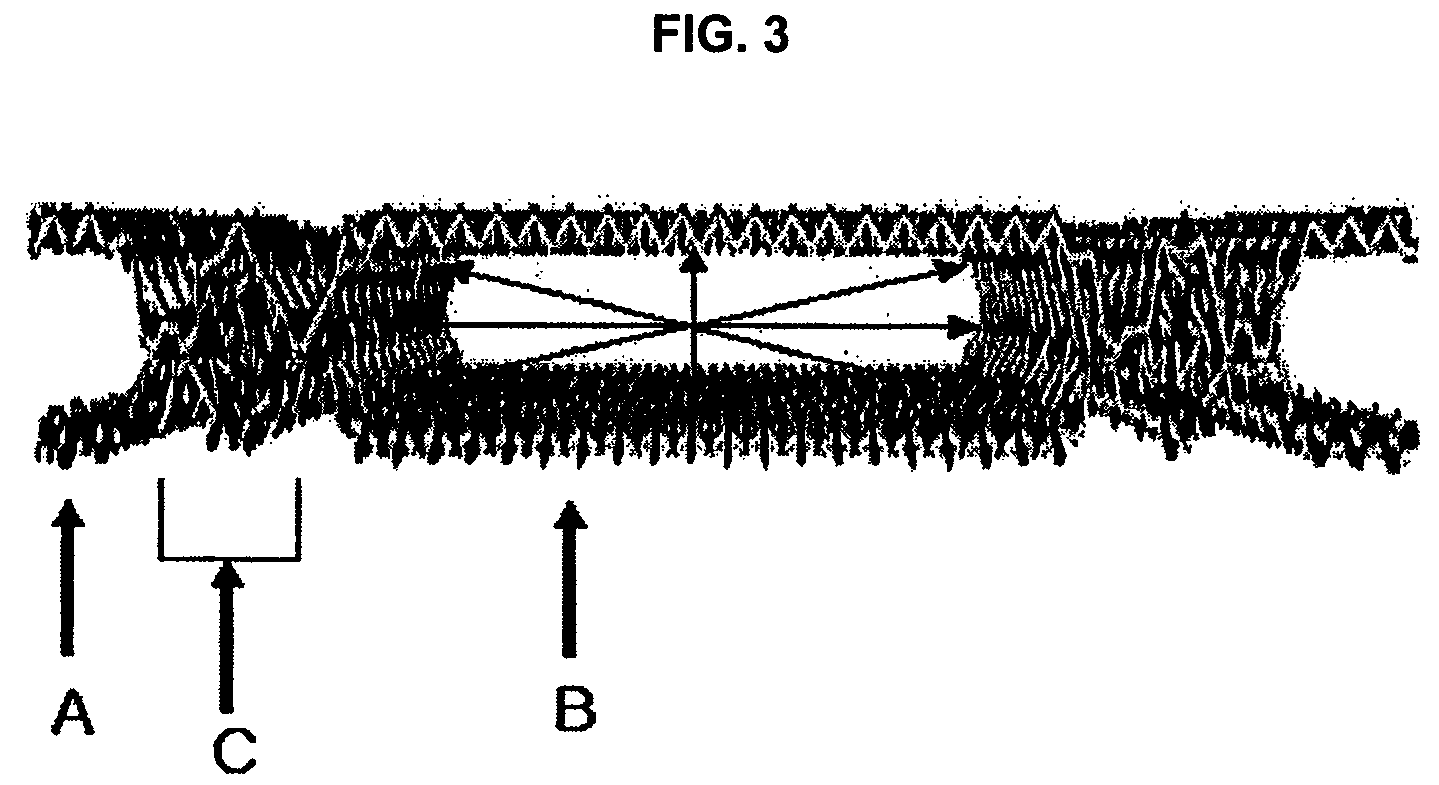Inflatable two-layer fabrics by gas
a two-layer fabric and gas technology, applied in the field of inflatable fabrics, can solve the problems of increasing manufacturing costs, complicated procedures, and weak attachment points, and achieve the effect of reducing the breathability property of the attachment area and minimizing air leakage at the attachment area
- Summary
- Abstract
- Description
- Claims
- Application Information
AI Technical Summary
Benefits of technology
Problems solved by technology
Method used
Image
Examples
example 1
[0062]A inflatable fabric, the left separator area (A) and the right separator area (B) of which having the structure shown in FIG. 1 and FIG. 2 and being separated by the attachment area (C) which comprised 20 yarns and was formed from a combination weave pattern of a 2 / 2 basket weave pattern and a partial attaching weave of plain double weave pattern, was prepared with a jacquard weaving machine using 426-denier polyamide multifilament as warp and weft. Both the warp density and the weft density were 52 number / inch, and the cover factor was 2,131. Then, silicone rubber was coated on both sides of the inflatable fabric by a two-step coating process (coating amount: 100 g / cm2). The fabric was cut and air leakage per unit length at the attachment area, thickness of a single fabric layer, and stiffness were measured. The air leakage per unit length at the attachment area was 0.6 l / min·cm, the stiffness was 2.5 kgf, and the thickness of a single fabric layer was 0.4 mm.
example 2
[0063]A inflatable fabric, the left separator area (A) and the right separator area (B) of which having the structure shown in FIG. 1 and FIG. 2 and being separated by the attachment area (C) which comprised 20 yarns and was formed from a combination weave pattern of a 2 / 2 basket weave pattern and a partial attaching weave of a double layer weave pattern, was prepared with a jacquard weaving machine using 315-denier polyamide multifilament as warp and weft. Both the warp density and the weft density were 60 number / inch, and the cover factor was 2,129. Then, silicone rubber was coated on both sides of the inflatable fabric by a two-step coating process of undercoating and top coating (coating amount: 100 g / cm2) in order to prevent air leakage at the attachment area. The fabric was cut and air leakage per unit length at the attachment area, thickness of a single fabric layer, and stiffness were measured. The air leakage per unit length at the attachment area was 0.7 l / min cm, the stif...
example 3
[0064]A inflatable fabric was prepared in the same manner as in Example 2, except that the coating amount of silicone rubber was changed to 90 g / m2.
[0065]The thickness of a single layer of the inflatable fabric measured by the ASTM D 1777 method was 0.39 mm and the stiffness value measured by the ASTM D 4032 circular band method was 1.9 kgf. An initial pressure of 50 kPa was applied to an airbag comprising the fabric, and the inner pressure of the airbag was measured 5 seconds later at 12.5 kPa. The seam strength of the attachment area (C of FIG. 2) measured by the ASTM D 5822 method was 119 kg / in and the breaking modulus was 43%. Also, the strength maintenance ratio measured by the coating fabric wear test according to the ASTM D 4157 method was 90%. To conclude, the fabric had good installation characteristics and inflatability for use as a side curtain type of airbag.
PUM
 Login to View More
Login to View More Abstract
Description
Claims
Application Information
 Login to View More
Login to View More - R&D
- Intellectual Property
- Life Sciences
- Materials
- Tech Scout
- Unparalleled Data Quality
- Higher Quality Content
- 60% Fewer Hallucinations
Browse by: Latest US Patents, China's latest patents, Technical Efficacy Thesaurus, Application Domain, Technology Topic, Popular Technical Reports.
© 2025 PatSnap. All rights reserved.Legal|Privacy policy|Modern Slavery Act Transparency Statement|Sitemap|About US| Contact US: help@patsnap.com



